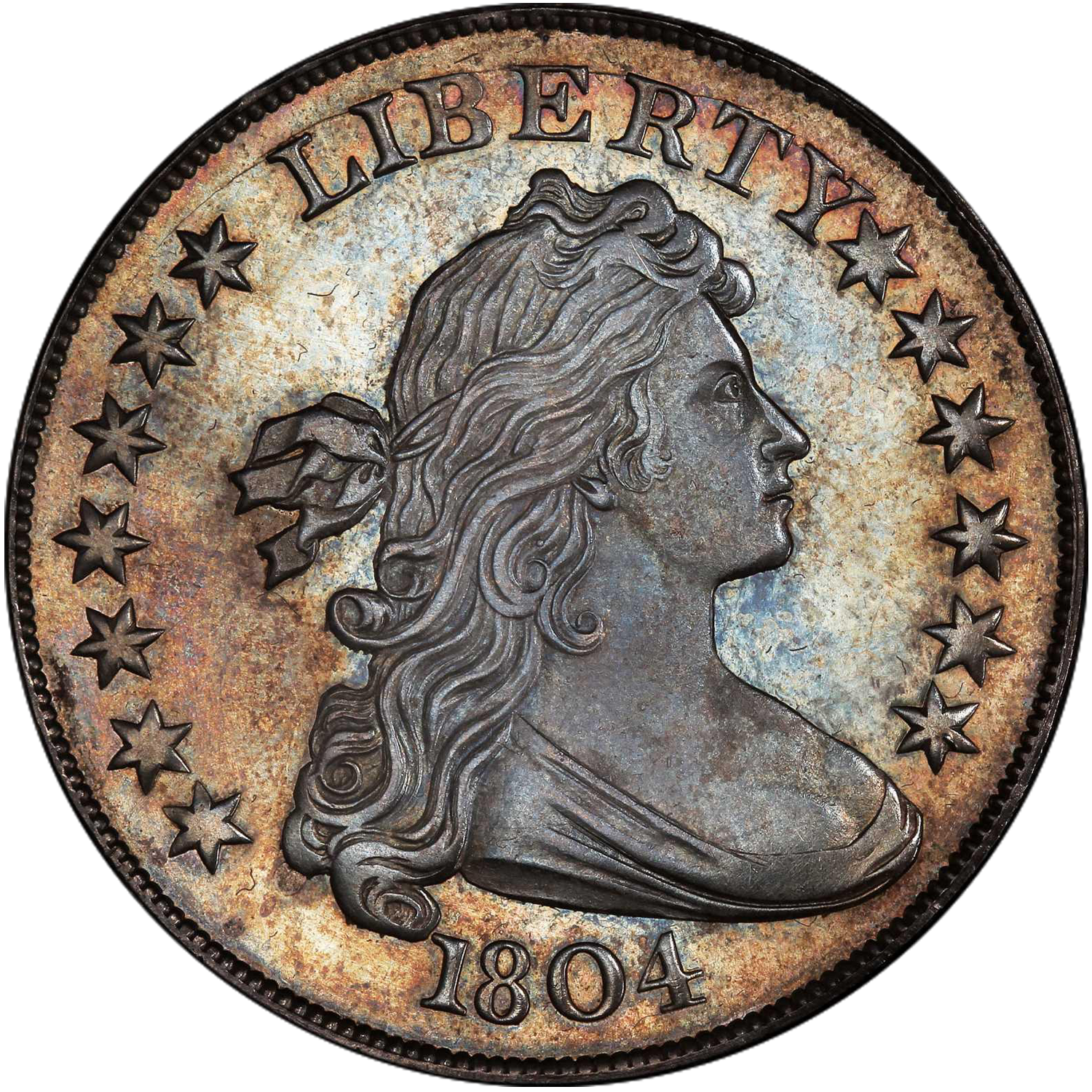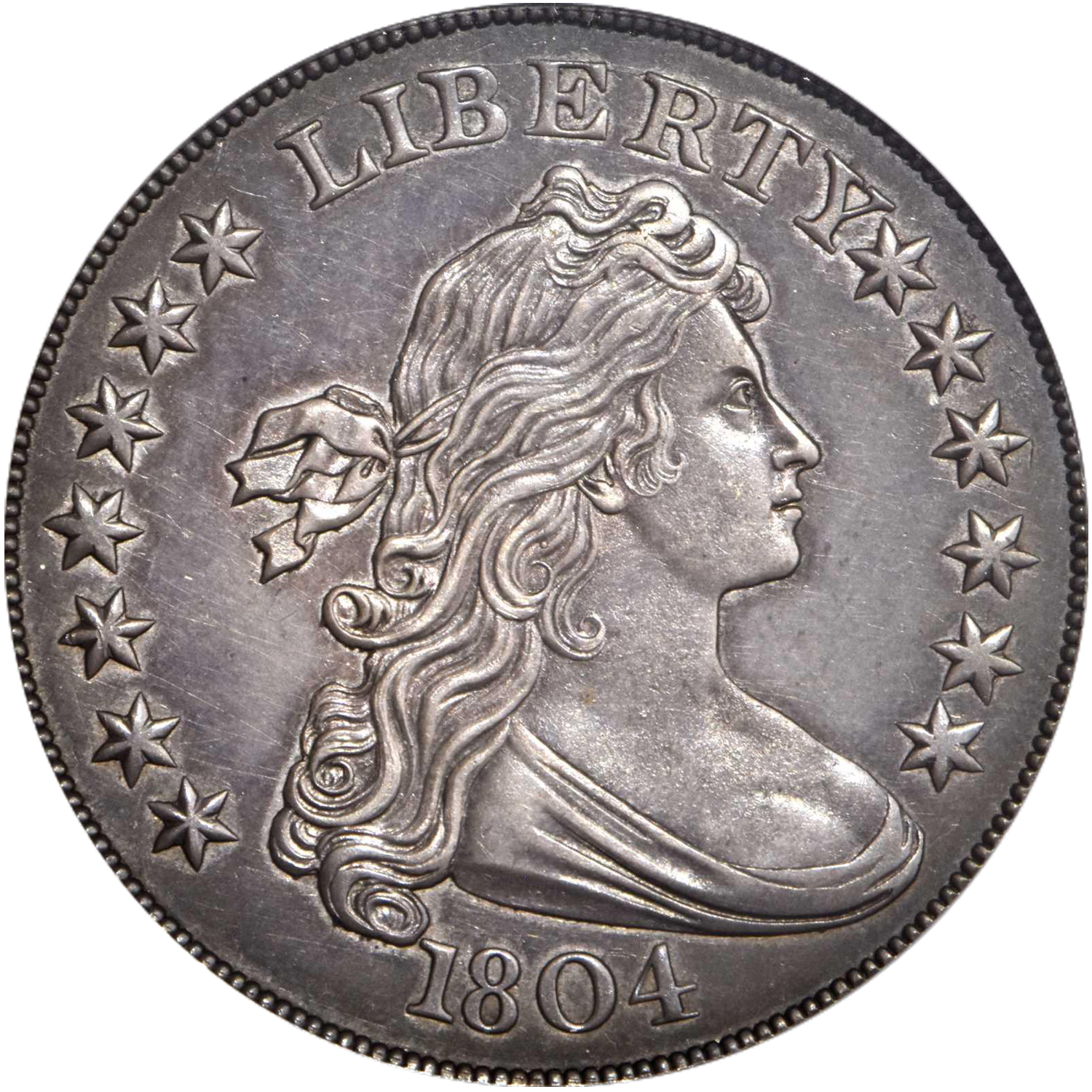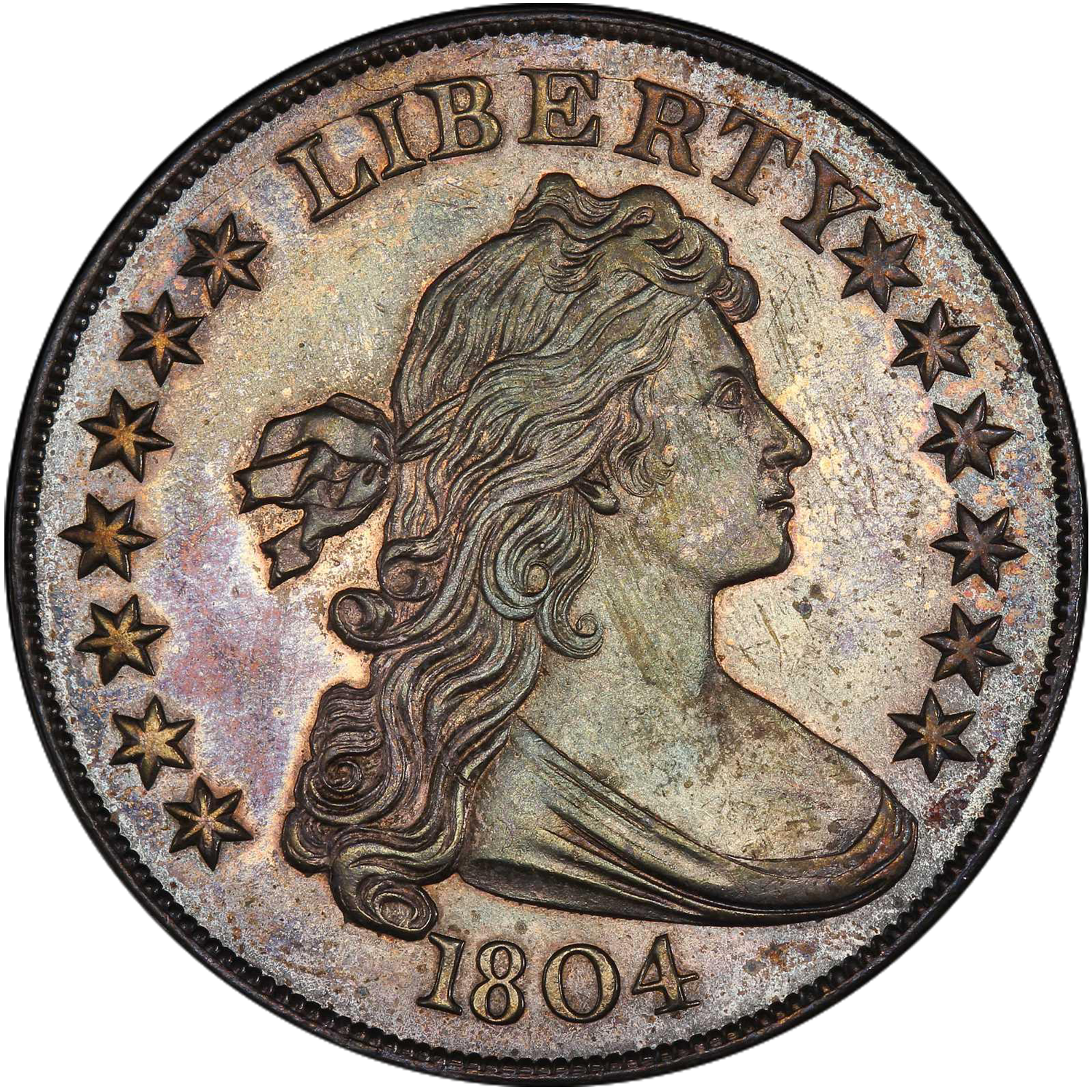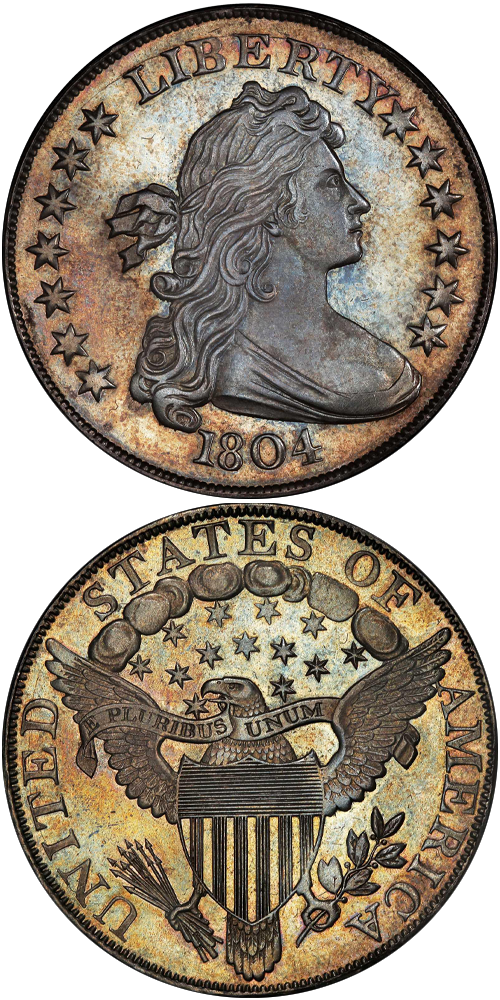1804 Draped Bust Dollar
Class I
There are rarer coins, but in the federal series there are none that challenge the fame, tradition, and glory given to the 1804 silver dollar. In 1941 B. Max Mehl called it "The King of American Coins," and it still commands that numismatic throne. Eight Class I dollars are known, one Class II (in the National Numismatic Collection in the Smithsonian Institution), and six of the Class III. The ownership of an 1804 dollar places the buyer in a Pantheon of numismatic fame.
History of the Class I 1804 Dollar
Though Mint records show a silver dollar mintage for 1804 of 19,570 pieces, these were all probably dated 1803. It was common practice at the early United States Mint to record annual mintages, but it was also common to use leftover, previously dated dies into the following calendar year, typically until the die steel gave out. The fact that only 15 Draped Bust 1804 dollars have ever come to light since the first notice of them appeared in print in 1842 — with certain others first appearing in collections after 1858 — gives testimony to the unreliability of the 19,570-piece mintage figure for 1804. After 1803, no dated circulation strike silver dollars were forthcoming from the Mint until 1,000 Gobrecht dollars were struck in 1836, followed by smaller numbers of that design in 1838 and 1839. In 1840 the new Liberty Seated design was introduced, marking the first year since 1803 that silver dollars were struck in significant quantity.
The story of the 1804 dollar was the subject of much speculation until 1962 when Eric P. Newman and Kenneth E. Bressett's book The Fascinating 1804 Dollar was issued by Whitman. In 1999 a detailed study by Q. David Bowers titled The Rare Silver Dollars Dated 1804 and the Exciting Adventures of Edmund Roberts added to the information. Other numismatic scholars have contributed valuable research and expanded the story along the way.
We now know that on November 11, 1834, the Department of State made a request for special sets of coinage of the realm to be made for presentation purposes to monarchs on the far side of the world. Detailed histories of two deliveries, one to the King of Siam and the other to the Sultan of Muscat, are given in the above-mentioned books. It was desired to include one of each authorized denomination: the half cent, cent, half dime, dime, quarter, half dollar, silver dollar, quarter eagle, half eagle, and eagle -- which were to be struck in Proof finish for inclusion in the specially made boxed sets. Most of these denominations were being made currently, and thus it was a simple matter to add 1834-dated Proofs. A search of mintage records revealed that silver dollars and eagles had last been minted in 1804. In order to make the sets accurately reflect history, Mint engravers prepared dies of the old designs for those two denominations.
Many of the eagles struck in 1804 actually bore that date, and in 1834 the Mint still had on hand an unused obverse die for this denomination from the period 1800 to 1804 (it was missing only the final digit in the date). This die was refinished, and the final digit 4 was added to ready it for coinage. Whereas the eagles struck in 1804 display a Crosslet 4 in the date, however, the die used in 1834 displayed a Plain 4, indicative of the change in style over the intervening 30 years. Credit for discovering the origin of the obverse die used to strike the 1804 Plain 4 eagles in 1834 goes to John W. Dannreuther. Interestingly, and as discovered by Bryce Brown and Bill Nyberg, the reverse die that the Mint used to strike these coins is an unused half dollar die leftover from 1806.
Regarding the silver dollar, in 1834 it was not realized that the dollars minted in 1804 had featured an earlier date. Thus, in 1834 the first 1804-dated dollars made their debut. Whether the dies for the 1804 dollar were made in 1834 or slightly earlier is a matter of debate. R.W. Julian suggests that they may have been prepared in 1831 in anticipation of a resumption in dollar coinage prompted by an increase in the United States' import of silver from the Orient. With the United States now importing more silver than it exported, Mint Director Samuel Moore requested that the ban on silver dollar coinage that had been in place since the early 19th century be lifted. Approval was forthcoming from President Andrew Jackson and the Treasury Department in the form of authorization to resume dollar coinage on April 30, 1831. According to Julian, the Mint prepared four obverse dies and two reverse dies using most of the same device punches used for original Draped Bust, Heraldic Eagle dies from before 1804. The first two obverse dies were dated 1802 and 1803, after which the top curl of Liberty's hair broke off the device punch for the bust. This broken punch was then used to create the dies that were dated 1804 and (much later) 1801. The two reverse dies, which Newman and Bressett have designated Reverse X and Reverse Y, differ in the placement of the lettering in the words STATES OF along the upper obverse. On Reverse X, the letter E in STATES is over a cloud, while on Reverse Y it is over a space between two clouds. Absent from all six of these dies was the denticulated border of the pre-1804 dies, the borders instead consisting of the beaded design current in the 1830s.
The Mint's intent may have been to use these newly created dollar dies to strike a number of patterns in preparation for the resumption of coinage on or after April 30, 1831. Or the intent may have been to have two die pairs ready for regular issue production, with two more obverse dies in reserve. In the end, however, the increase in silver imports proved temporary and the plans to resume dollar coinage in 1831 came to an end before any coins (patterns or otherwise) were struck. Opinions vary, with some numismatists asserting that the dollar dies were not prepared until the need arose in 1834 after the Mint received the Department of State's request for special presentation sets. If so, then why the first two obverse dies prepared were fully completed with the dates 1802 and 1803 is curious. The Mint's need in 1834 was for 1804-dated dollars, so on the surface it seems to make little sense for the engravers to date the first two obverse dies (intact hair curl) 1802 and 1803, and then date the third (broken hair curl) 1804. All three of these obverse dies display similar date logotypes that were obviously prepared to mimic the style on the original Draped Bust dollars dated 1800 to 1803. In any event, the Class I 1804 dollars were struck before the 1802- and 1803-dated Proofs, as confirmed by the progression of reverse die states (all three were struck from Reverse X). Apart from the bust, the fourth obverse die -- that eventually dated 1801 -- remained unfinished until a much later date, as evidenced by the radically different style of stars and date logotype. The Proof 1801 coins were likely struck around the same time as the Proof 1803 specimens.
Other opinions concern the second reverse die, Reverse Y per Newman and Bressett's designation. Diverging from the Julian theory, some researchers believe that this die was produced in the late 1850s concurrent with the desire to create additional specimens for the numismatic trade.
Returning to 1834, the Mint used the 1804-dated obverse and Reverse X to strike the silver dollars included in the special sets of coinage requested by the Department of State. These are the coins that numismatists now refer to as the Class I 1804 dollars. In further keeping with the design of the coins that the Mint believed had actually been struck in 1804, the old Castaing machine was used to add edge lettering to the planchets before striking. This edge lettering, however, was slightly crushed when the coins were struck with the close collar in use at the Mint in 1834. Indeed, the edge is among the technical aspects of the 1804 dollars that places the striking of the Class I examples in the mid-1830s. Before Eric Newman and Ken Bressett undertook their research project on 1804 dollars, even the most basic fact relating to 1804 dollars -- the question of when they were struck -- was not entirely settled. Independent of their inquiry into the 1804 dollar's documentable history, Newman and Bressett studied the coins themselves, knowing that what is written in metal can reveal truths that go unsaid on paper. Among their findings were the "raised flat border and dentilation" common to all 1804 dollars, "a style first adopted at the U.S. Mint in 1828." The size of the dies and the crushed edges both pointed to production in the age of the "collar die device [that was then] under development for the new Mint in the 1833-36 period," as does the weight standard of all Class I specimens, which conforms to the 416 grain pre-1837 standard.
William E. DuBois, the keeper of the Mint Cabinet and an assistant assayer at the Philadelphia Mint, coauthored a work in 1842 with fellow assayer Jacob R. Eckfeldt entitled A Manual of Gold and Silver Coins of All Nations, Struck Within The Past Century. It was intended as a cambist, a guide for bankers and merchants, but became one of the first standard references for American coin collectors. Illustrated by the ingenious medal ruling machine invented by photographic pioneer Joseph Saxton, the Eckfeldt and DuBois Manual was the very first work to depict a genuine 1804 dollar. Mixed in with more commonplace coins on Plate II, it is described perfunctorily in the text, with no mention of its interest or rarity. The image caught the attention of Matthew A. Stickney, one of the preeminent collectors of the age. In May 1843, Stickney traveled from his home in Salem, Massachusetts to Philadelphia to visit the Mint Cabinet, where he successfully obtained an 1804 dollar in trade for himself. He was offered another by DuBois less than two months later. In a letter dated July 12, 1843, DuBois said of the second offered example: "this I was obliged to take out of the cabinet, where there happened to be a duplicate. It is out of the question to get a piece struck from dies earlier than 1837, since they are of a different standard, both weight & fineness, and as planchets are made." This letter provides further evidence that all Class I 1804 dollar were struck before 1837, and that while restrikes could be struck for some rarities, the differences mentioned precluded such production of new 1804 dollars.
Exactly how many Class I 1804 dollars were struck during the 1830s is unknown, but given the special nature of these coins and the fact that their rarity was appreciated from an early date, the extant population of eight specimens probably represents the entire mintage. Although these coins have often been referred to as the "original" 1804 dollars, that term is inaccurate since they were not struck that year. They are also not "restrikes" since the first 1804-dated dollars were produced in 1834. The Class I 1804 dollars, along with the Proof 1801, 1802 and 1803 coins, are most accurately described as novodels, a term borrowed from Russian numismatics that refers to coins struck from newly created, backdated dies.
On board the sloop USS Peacock when she departed New York Harbor on April 23, 1835, were four of the special coinage sets requested by the Department of State, each of which included a Class I 1804 dollar. Two of these gift sets, one boxed in red leather, the other in yellow leather, were delivered by Edmund Roberts, special envoy of President Andrew Jackson. One set was presented to the Sultan of Muscat in October 1835 (see below). That now known as the King of Siam set, which we (Bowers and Merena) offered in October 1987, was presented by Roberts in April 1836. The other two sets, intended for the emperors of Cochin-China and Japan, were never delivered as Roberts became sick and died in June 1836, before completing his mission. The sets were presumably returned to the Department of State when the Peacock returned to the United States in November 1837. The four additional Class I 1804 dollars (ie., those not included in diplomatic Proof sets) were retained by Chief Coiner Adam Eckfeldt and included in the Mint Cabinet when the collection was formed in 1838. Three of those were eventually dispersed by the Mint, at least one in trade for other objects for the Mint Cabinet collection, while the fourth remained in that collection and now resides in the Smithsonian Institution. These eight pieces make up the entire known population of Class I 1804 dollars. By name these are the Sultan of Muscat specimen, King of Siam specimen, Stickney specimen, Dexter specimen, Parmelee specimen, Mickley specimen, Mint Cabinet specimen, and the Cohen specimen. Several of these Class I 1804 dollars are permanently impounded in or on loan to museum collections.
Roster of Class I Original 1804 Dollars
The foundation of this roster is credited to Q. David Bowers in the 1993 edition of his reference Silver Dollars & Trade Dollars of the United States, our (Bowers and Merena's) cataloging of the Stickney specimen for the April 1997 Eliasberg Collection sale, and work presented in Heritage's June 2018 Long Beach Signature Auction catalog, lot 4003, in which the Mickley specimen of the Class I 1804 dollar was offered. Provenance information was also checked against the census listed on the PCGS CoinFacts website (accessed May 2021).
1 | PCGS Proof-68 | The Sultan of Muscat Specimen
• Chief Coiner Adam Eckfeldt
• U.S. Department of State, c/o Edmund Roberts
• Sayyid Sa'id-bin-Sultan (Sultan of Muscat), as part of a cased presentation set
• Unknown intermediaries
• Charles A. Watters of Liverpool, England
• May 1917, Glendining & Co.'s sale of the Watters Collection, London, Lot 227
• Henry Chapman
• Virgil Brand
• Brand Estate
• Armin W. Brand
• Horace Louis Philip Brand
• Ruth and Charles Green
• Charles Frederick Childs
• F. Newell Childs
• Charles Frederick Childs II
• August 1999, Our (Bowers and Merena's) sale of the Walter H. Childs Collection, Lot 458
• Mack and Brent Pogue
• May 2016, Offered in our (in conjunction with Sotheby's) sale of the D. Brent Pogue Collection, Part IV, Lot 4020.
—
2 | PCGS Proof-67 | The King of Siam Specimen
• Chief Coiner Adam Eckfeldt
• U.S. Department of State, c/o Edmund Roberts
• King Ph'ra Nang Klao (Rama III) of Siam, as part of a cased presentation set, in which it is still included
• David F. and Philip Spink, who acquired the set privately during the 1950s. According to traditional numismatic wisdom, sometime during the 19th century the King of Siam set passed to Anna Leonowens, known as Anna of Siam and memorialized in the musical The King and I. David Spink purchased the set from two elderly ladies in England who were reported to be her descendants. There is no evidence to support this connection.
• Elvin I. Unterman, via agent Lester Merkin
• October 1987, Our (Bowers and Merena's) King of Siam Sale, Lot 2209, unsold
• Stack's, as agent for the owner
• Rarities Group (Martin Paul) and Continental Rarity Coin Fund I (Greg Holloway)
• May 1990, Superior's Father Flanagan's Boys Home Sale, Lot 3364
• Iraj Sayah and Terry Brand
• February 1993, Superior's January-February 1993 Auction, Lot 1196
• Spectrum Numismatics
• Private western collection
• November 2005, Goldberg Coins, privately, to Steve Contursi and private collector.
—
3 | PCGS Proof-65 | The Stickney Specimen
• Chief Coiner Adam Eckfeldt
• May 9, 1843, Matthew Adams Stickney
• June 1907, Henry Chapman's sale of the Matthew Adams Stickney Collection, Lot 849
• Col. James W. Ellsworth
• Wayte Raymond
• William Cutler Atwater
• Atwater estate
• June 1946, B. Max Mehl's sale of the William Cutler Atwater Collection, Lot 213
• Louis E. Eliasberg, Sr.
• Eliasberg estate
• April 1997, Our (Bowers and Merena's) sale of the Louis E. Eliasberg, Sr. Collection, Lot 2199
• Spectrum Numismatics
• Larry H. Miller
• December 2020, Our sale of the Larry H. Miller Collection, Lot 1094.
—
4 | PCGS Proof-65 | The Dexter Specimen
• Chief Coiner Adam Eckfeldt
• Unknown intermediaries, possibly S.H. and H. Chapman
• October 1884, Adolph Weyl's 46th Auction, Lot 159
• S.H. and H. Chapman
• May 1885, S.H. and H. Chapman's Chapman Sale, Lot 354
• Scott Stamp & Coin Company
• James Vila Dexter
• Dexter estate
• H.G. Brown
• October 1904, Lyman Low's sale of the H.G. Brown Collection, Lot 431
• William Forrester Dunham
• B. Max Mehl
• June 1941, B. Max Mehl's W.F. Dunham Collection sale, Lot 1058
• Charles M. Williams
• Abe Kosoff and Sol Kaplan
• Harold L. Bareford
• October 1981, Our (Stack's) sale of the Harold L. Bareford Collection, Lot 424
• RARCOA (Ed Milas)
• Leon Hendrickson and George Weingart
• July 1989, RARCOA's session of Auction '89, Lot 247
• American Rare Coin Fund, Ltd. (Hugh Sconyers)
• Northern California collector
• July 1993, Superior's Baltimore '93 Auction, Lot 551, unsold
• Northern California collector
• May 30-31 1994, Superior's U.S. Coin Auction, Lot 761
• Harlan White
• Private southeastern collection
• October 2000, Our (Stack's) 65th Anniversary Sale, Lot 1167
• Mack and Brent Pogue
• March 2017, Our (in conjunction with Sotheby's) sale of the D. Brent Pogue Collection, Part V, Lot 5045
• Kevin Lipton and John Albanese
• Bruce Morelan, via Legend Numismatics
• October 2020, Legend Rare Coin Auctions' sale of the Bruce Morelan Collection, Regency Auction 41, Lot 25.
—
5 | ICG Proof-64 | The Parmelee Specimen
• Chief Coiner Adam Eckfeldt
• Unknown intermediaries
• "an aged lady" who gave the coin to her son
• E. Harrison Sanford
• November 1874, Edward Cogan's sale of the Sanford Collection, Lot 99
• Lorin G. Parmelee
• June 1890, New York Stamp & Coin Company's sale of the Lorin G. Parmelee Collection, Lot 817
• Byron Reed
• Omaha City Library
• Western Heritage Museum (now the Durham Museum).
—
6 | PCGS Proof-62 | The Mickley Specimen
• Chief Coiner Adam Eckfeldt
• Unknown intermediaries
• Henry C. Young, a teller at the Bank of Pennsylvania
• Joseph J. Mickley
• October 1867, W. Elliott Woodward's sale of the Joseph J. Mickley Collection, Lot 1676
• William A. Lilliendahl
• Edward Cogan
• William Sumner Appleton
• 1905, Massachusetts Historical Society
• October 1970, Our (Stack's) sale of the Massachusetts Historical Society Collection, Lot 625
• Chicago collection
• Reed Hawn, via Stack's
• October 1993, Our (Stack's) sale of the Reed Hawn Collection, Lot 735
• David Queller
• April 2008, Heritage's sale of the Queller Family Collection of Silver Dollars, CSNS Signature Auction, Lot 2089
• Greensboro Collection
• August 2013, Heritage's sale of Greensboro Collection, Part IV, Rosemont Signature Auction, Lot 5699
• June 2018, Heritage's sale of "An Important New York Collection," Long Beach Signature Auction, Lot 4003.
—
7 | Impaired Proof | The Mint Cabinet Specimen
• Chief Coiner Adam Eckfeldt
• Mint Cabinet
• National Numismatic Collection in the Smithsonian Institution.
—
8 | Proof-30 | The Cohen Specimen
• Chief Coiner Adam Eckfeldt
• Unknown intermediaries
• Circa 1865, Edward Cohen, passed over the counter at his exchange office in Richmond, Virginia
• Col. Mendes I. Cohen, Baltimore, Maryland
• October 1875, Edward Cogan's sale of the Colonel Mendes I. Cohen Collection, Lot 535
• Henry S. Adams
• November 1876, Edward Cogan's sale of the Henry S. Adams Collection, Lot 356
• Lorin G. Parmelee
• Henry G. Sampson
• Major William Boerum Wetmore
• June 1906, S.H. and H. Chapman's sale of the Major William Boerum Wetmore Collection, Lot 208
• S.H. and H. Chapman
• Thomas L. Elder
• James H. Manning
• May 1921, B. Max Mehl's sale of the James H. Manning Collection, Lot 778
• Elmer S. Sears
• B. Max Mehl
• Lammot DuPont
• Willis H. DuPont
• Unknown thieves, recovered in Zurich, Switzerland, April 23, 1993
• Donated to the American Numismatic Association Museum
The example to the left was sold by Stack's Bowers Galleries in the August 2021 ANA Auction, where it realized $7,680,000.
1804 Class I Draped Bust Dollar Auction Highlights
 PCGS PR-68 Sold for $7,680,000 View Lot 4114 |  PCGS PR-65 Sold for $3,360,000 View Lot 1094 |  PCGS PR-65 Sold for $3,290,000 View Lot 5045 |






